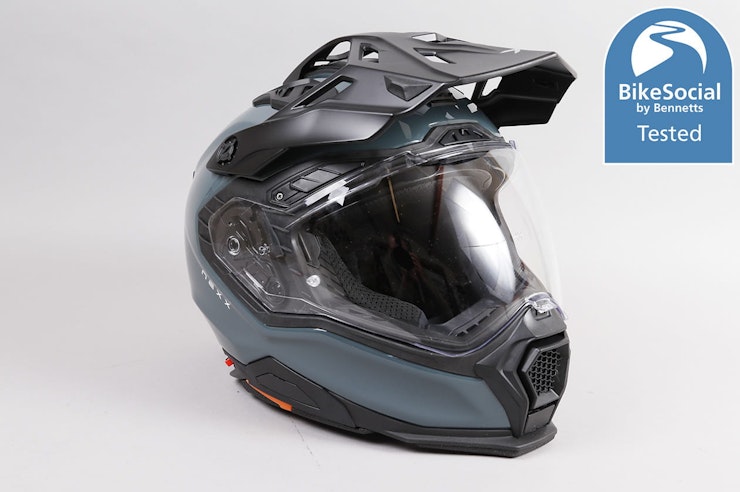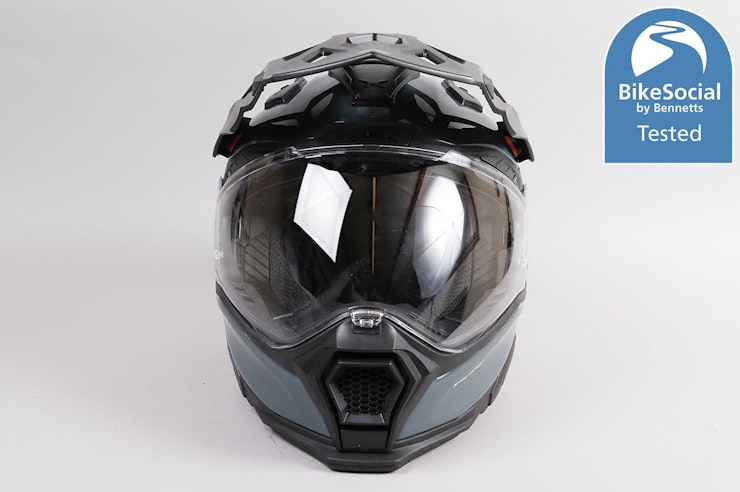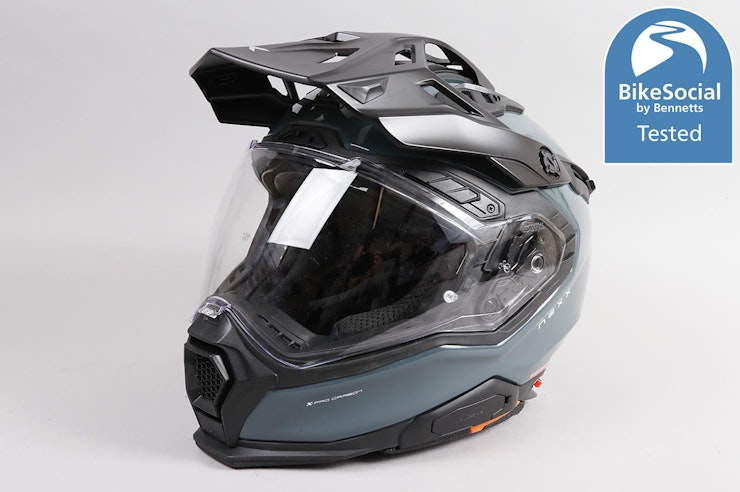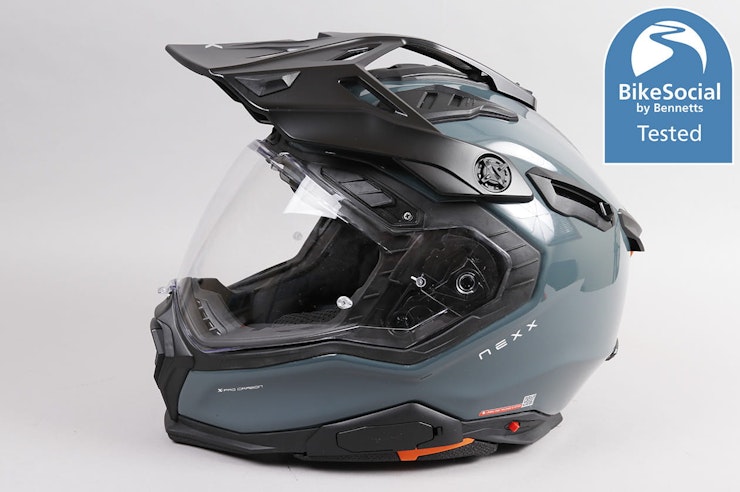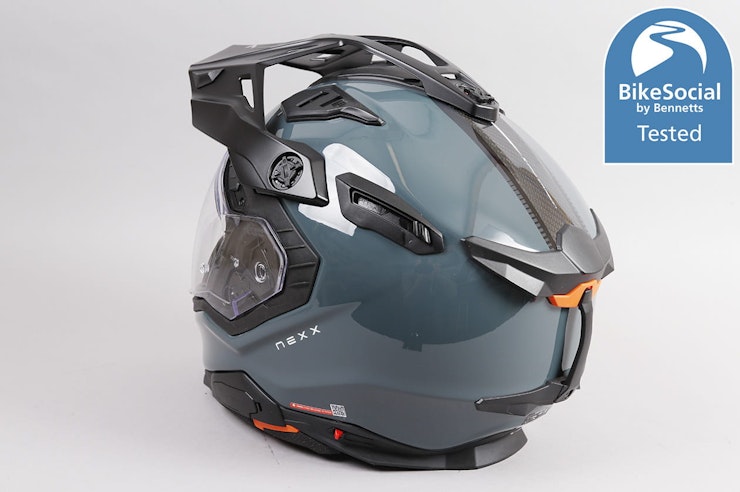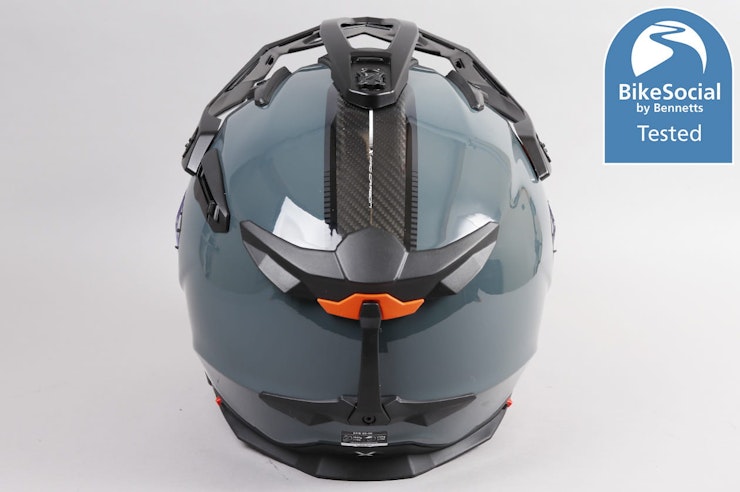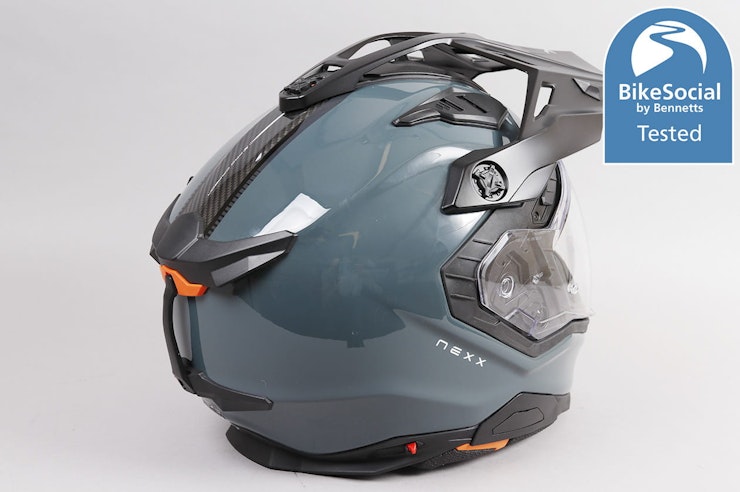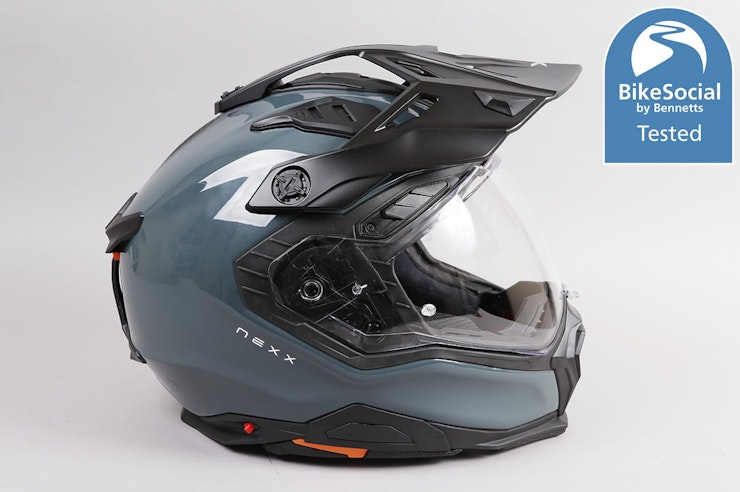Nexx X.WED 3 review | Adventure helmet tested
By BikeSocial Member
Everyday riders, just like you...
26.03.2024
Date reviewed: March 2024 | Tested by: BikeSocial member Ben Cordy | RRP: From £329.99 | nexx-helmet.co.uk
With an already strong following within Europe – especially among adventure bike riders – Portuguese brand Nexx has built a reputation for feature-packed, practical yet sharp-looking helmets. The latest iteration of its flagship adventure helmet, the Nexx X.WED3 on review here, has a lot to live up to…
Having put the X.WED3 to daily use over the past month on my Honda CB500X, it’s ploughed through the daily commute, some light trails and more than a few inclement motorway runs. Here’s wheat I think of it…
Fantastic visibility
Extremely versatile and well equipped
Great range of ventilation options
Persistant fogging on an area of the Pinlock
Peak can be noisy at speed on my bike
Some minor build quality concerns
Nexx X.WED3 vs Nexx X.WST3
Which is the best Nexx helmet for you?
The Nexx X.WED3 can be worn with our without the peak, and you can have the visor or goggles, so it’s potentially four helmets in one. Plus the Pro versions come with a black visor.
Outer shell
The X.WED3 is available in two outer shell options, a ‘Matrix’ Multi-Composite Fibre shell at £329.99 in plain colours or £399.99 in graphics, and a full carbon X-Pro shell, which starts at £469.99 for the ‘Wild Pro’ plain colour with a stripe of carbon exposed, and rises to £509.99 for the graphics and plain carbon finishes.
It’s also important to note that, besides having carbon fibre outer shells, the Pro versions of the X-Wed 3 also have the following additions:
Dense foam bumpers at sides of skirt (just under the chin on the standard lid)
Pinlock 120 anti-fog insert (instead of 70)
80% tint dark visor as well as clear
Magnetic strap retainer on chin strap, instead of popper
Elastic straps on the neck skirt for a hydration pack
The Pro versions have a carbon fibre shell. The bare carbon and graphics models are more expensive as the weave is exposed so has to be cosmetically perfect
The entire range comes in three separate shell sizes with XXS-S in one, M-L in another and L-XXL sharing the biggest outer shell. In general the outer proportions of the shell are fairly in keeping with other helmets although the peak, goggle clip and protective collar bumpers do make it a tad larger and an awkward helmet to fit into top boxes for storage. My gargantuan 58 litre Givi box just about manages at a very specific angle but I suspect smaller boxes might struggle.
The carbon variant I have on review utilises layered carbon fibre that’s cut and moulded by Nexx in its Portugal factory, but both the carbon shell version and the more basic composite ‘matrix’ shell version (also made in-house) meet the new ECE 22-06 standard for helmets, which includes tougher testing of impacts and penetration over a wider range of angles.
The base of the outer shell has a number of other additional safety elements, with the chin said to be shaped specifically to reduce the risk of breastbone injury.
Nexx also added ‘X-Foam’ crash bumpers to the collar of the Pro version to reduce the chance of collar bone injuries, which can be particularly common in off-road crashes. It’s great to know that both of these eventualities have been factored into the design, although I did find the X.WED3 sits quite low at the neck, and with the bumpers I felt a little more aware of the contact between the helmet and my jacket than with other lids. The trade-off is definitely worth it to lower the risk of those injuries, and from personal experience chest injuries are not a lot of fun.
Within the outer shell Nexx also managed to fit a number of additional integrations and features. While these might not be of benefit to all, many will appreciate the inclusion of three camera mounting points – one on the chin, another on the top of the head (with or without the peak fitted) and a third on the right-hand side – using the supplied good-quality brackets. It’s fantastic to see this incorporated to the helmet’s design and a great feature to have. The only negative to these is I found the threads of the mounting points a little rough; enough that I was worried they were incorrectly threaded. It’s worth noting the version on test is a press/prototype version so this may be corrected in the final form. I did also notice this on the early X.WST3 I reviewed, but on the X.WED3 Pro I tried, which was from normal production, the threaded inserts are perfect. John Milbank, Consumer Editor
I did also find the blanking cover on the side mount snapped a tab on first removal. The blanking plate is only cosmetic though, and spare parts will be available from the UK importer, Motohaus (I tried to recreate this issue on another X.WED3 and an X.WST3 and couldn't. John). There are also pre-prepared slots for the two fully integrated comms system designed with Sena, a full review of which you can find here.
Weight
In a medium, the X.WED3 weighs a measured 1,752g without the peak, and 1,867g with it. The optional Nexx X-COM3 adds an additional 85g. This is a bit heavier than the Arai Tour-X5, which in BikeSocial’s testing came in at 1,736g with the peak.
While on paper that might seem quite heavy, especially comparing it to a conventional full-face helmet, it’s worth noting that it includes a drop-down sun visor, the fittings for the accessory camera mounts, preparations for the integrated comms and lining release mechanisms, all features missing from the Arai compared above. Would it likely be a little lighter without all of these extras? Probably, but they add a great deal of benefit and the fact that Nexx has managed to get them all in is impressive.
In actual use that weight doesn’t make much notable difference anyway, and I would in no way note this as feeling any heavier than the other helmets I’ve owned and used. Ultimately, it’s the aerodynamics that really matter.
Ventilation
Ventilation is another very impressive area of the X.WED3’s design. Air channels and pockets within the EPS are backed up by 11 vents across the helmet, with three across the brow, three slightly larger vents on the crown, a large filtered mouth vent and four exhaust vents at the back. The mouth vent and front vents are all closable using easy-to-access sliders, although the crown vents are a little trickier to operate on the move when the peak is fitted. While the closable vents only have two positions – open or closed – the sheer number of them give a broad range of possible ventilation options.
In practice every vent makes a tangible difference, unlike some helmets where the effect of opening one can at times be hard to distinguish. Despite testing in chilly spring conditions, I can see how well this helmet is likely to perform in warmer climates.
In keeping with the rest of the X.WED3, it’s nice to see the inclusion of a couple of air-flow related accessories. There’s a chin skirt that further improves the seal around the collar and help with sound management, which is fiddly to fit – popping out a few times when I removed the helmet owing to struggling to fully seat the edge of the skirt in the recess designed for it – but when there it did make a small difference.
Nexx has also included a winter insert for the mouth vent, which replaces a mesh bug filter held in place by a X-shaped plastic frame across the inside of the chin guard. When fitted the air flow is all-but stopped to the mouth; something that may prove very useful for the deep winter months.
Whether it’s the various air channels within the inner liner, or the myriad of vents, ventilation is one of the X.WED3’s strongest suits and no doubt part of what makes Nexx adventure helmets so popular on the continent, and it’s interesting to see a cheek vent too, which is fed from inside the visor aperture and intended to allow a little more air to get to the cheeks, through the material. You can’t feel it, but it could help that little bit when riding with goggle in.
Visor
The X.WED3 benefits from an extremely large visor giving excellent visibility both side to side and vertically. In my normal sat riding position on the CB500X and without moving my head I have an almost uninhibited view side to side, and significantly more ground visibility than in my usual helmets, which has proven especially helpful on trail rides thanks to a greater understanding of the terrain, and allowing me to spot and avoid obstacles I might have otherwise not seen. Greater visibility is a common benefit of adventure-style lids but the clarity and shape of the X.WED3’s visor is great.
The visor has three positions in addition to closed and just cracked open, which is okay but not perfect, the first open position is quite high, placing the lower edge of the visor directly in your eye-line. It would have been preferable to have a few more options here, perhaps a 1cm open position.
That being said, the Nexx’s impressive ventilation somewhat makes up for this with plenty of airflow across the face possible with the right combination of vents.
Unusually the X.WED3 also includes a drop-down sun visor, a feature not always seen in other adventure helmets. This is implemented well with a lever to lower it just behind the left peak mounting point. The visor is really high quality with no distortion and lowers to the perfect position leaving just over a finger’s width from the bottom of the visor aperture. On the move and with the peak in place the lever can be a little tricky to find at first and would benefit from being a little larger to find with gloved hands, but with time you get used to it.
The Pro versions of the X.WED3 come with an additional 80% tint main visor, and there’s also a 60% tint option plus a range of iridium-coloured visors that you can buy as extras.
Like the clear visor, the supplied dark one proves free from distortion and despite a fairly strong tint I didn’t find it excessive on early mornings or late afternoon commutes, although it is understandably marked for ‘daytime use only’. With the drop-down lens and these accessory options there are a wide range of setups possible, making it easy to customise the helmet to your riding conditions.
The X.WED3 Pro comes with a top-spec 120XLT Pinlock anti fog insert (it’s a mid-range 70 on the lower-priced non-Carbon Fibre models). This is an especially large pinlock covering the central width of the visor and extending to just above the lower seal. It also has a slightly different pin/notch arrangement to the inserts I’ve used before with a wider recess in the insert for the pin to sit within. This gives a little more range of positioning for the insert but flexing the visor to flatten it sees the Pinlock snap into its natural place when fitting.
Unfortunately, although the eye level portion of the pinlock performed well I had continual issues with the lower part of the insert, below my nose, which would become easily overwhelmed with moisture during cold, damp weather, fogging persistently showing up on the surface during use.
Although this was especially noticeable in wet and cold conditions it was visible to some degree throughout my testing. Despite trying several combinations of venting, and removing the Pinlock insert for a thorough dry out, the fogging would continue to appear within 20 minutes of riding. While this hasn’t spread further, it’s proven distracting and a let-down on an otherwise very impressive piece of kit.
The seals around the visor work really well with no leaks or rain getting through when closed. Despite riding in some fairly grotty conditions there was no noticeable water ingress throughout the helmet. The visor release mechanism is simple to use too, with a lever on each side to release. Refitting requires the position nib to be lined up before clipping the visor pivot into place, but it’s very quick and simple to do once you’ve got the knack.
With the visor removed the helmet comes supplied with blanking plates to cover the mechanism, converting it into full off-road mode. These plates along with the goggle retainer on the back instantly transform the helmet into something far more reminiscent of an MX lid. In this mode there’s plenty of room for even larger google styles and the supplied peak extender further adds to the functionality of a true off-road capable helmet.
Lining
The soft fabric liner, which is made by hand in the Nexx factory, uses an anti-sweat, anti-allergic material that features a system the company calls ‘X-MART Dry’. It’s said to allow for the rapid drying out of the helmet’s soft material in the event of a wet and/or sweaty ride. In practice it seems to do precisely that, drying out well from some of the extremely soggy rides I’ve tested it in. This is further helped by the fact that the lower cuff of the liner is a leatherette/suede finish and so less prone to absorbing water. I don’t generally suffer from a sweaty head but with the ventilation provided by this helmet and the choice of materials here I have every confidence it will perform as well as if not better than most when faced with extremes of weather.
One of the features I was most impressed with was the liner release system used in the XWED3. The ‘FRS’ release system is patent-pending and while I initially thought this would be something of a gimmick, it actually works really well. There’s a simple sliding catch on each side of the helmet locked in position by a small rubber bung. Releasing this and sliding the catch allows you to smoothly slide the cheek pads from their positions. Replacing is just as easy, pushing the pads back into position and sliding the catch back into place with the bung to prevent it opening on its own.
There are three ‘vertical’ clips on the cheeks of the pads that pop directly into the plastics of the inner shell, doing away with the poppers used in many other helmets, which could loosen over time. This set-up makes full removal of the lining for cleaning far quicker and in the event of an emergency should prove helpful to emergency workers needing to remove the helmet gently.
Editor’s note: Without prior knowledge it's not immediately obvious how to release the pads. There’s a QR code next to the latches, but scanning it takes you to an advice page on the Nexx Website. First you have to select the region you’re in, then there's a list of options for all the lids, so an emergency responder would need to know the model. After that, you have a drop-down menu that starts with ‘how to remove the [goggles] strap holder’. The fourth one is ‘Remove lining’. Click on this and it takes you to a YouTube video about lining removal. After an advert, you can watch how to do it. I really hope that Nexx changes this QR code to link to a very clear, simple step-by-step photo guide that comes up instantly when viewing, without any further clicks.
It’s also nice to see small touches such as elastic straps (on the Pro version only) to attach and route hydration tubes on the lower collar of the lining. These are well implemented and attention to details like this are a big part of what’s made Nexx popular with the adventure market.
Fastening
A traditional double-D ring strap is used for a simple but effective fastening system. The strap is unusually long but thanks to the ‘X-Lock’ magnetic strap attachment (Pro version only – it’s a popper on the non-carbon fibre model) excess is kept out of the way fairly well. To aid with this the end of the strap has a large rubberised magnetic strap tab that I have a love hate relationship with. On one hand it’s super-easy to find and grab in order to do it up, but on the other its size makes it a bit fiddly to fit through the D ring, especially when wearing gloves.
Nexx tells me that the strap is long to make it strap easier to find, grab and secure.
Fit
While helmet fit is always a subjective matter, the sizing and shape of the X.WED3 is for me a vast improvement over the previous generations. I tend to struggle with rounder profile helmets and actually nearly bought the Nexx X.WED2 but found it to have a little too much pressure front to back. Thankfully the new generation appears to be a slightly more oval profile and the large on test here has proven to be true to size for my large head.
Although there aren’t specific grooves for glasses wearers, the cheek pads transition to the crown liner in just the right spot, so when testing with my sunglasses there was no undue pressure on the arms and plenty of room for the frames in the wide visor aperture to the front.
As always, helmet fit is crucial to remaining safe and distraction free when riding. I’d always recommend trying a helmet on before purchase and with a new distributor (Motohaus) managing Nexx in the UK the hope is there with be a broad range of retailers to visit for a test once the new range launches.
Cover plates replace the visor when using googles, and include ridges to hep grip the strap. Yet another nice design touch
Noise
The noise performance of the X.WED3 is an area that really surprised me. I found the X.WED to perform equally as well as my usual daily helmet (a Shoei Neotec 2), helped in part by the seal around the neck line. Sound is kept at a real minimum and in its street form I’d dare say that in some ways out-performed my Shoei. I also noted changes to the ventilation seemed to make less impact to the sound levels than some other helmets too, something I think is down to the way air is channelled through multiple small vents rather than a few larger openings. Of course, having said that it’s the bike that makes the difference, with the screen and fairing affecting the noise, not to mention the rider’s height, seating position and riding style. One person can find a helmet to be quiet, another might swear it’s noisy.
The only caveat to the above is the impact of the peak. As with all peaked helmets there’s a droning sound at higher speeds caused by the peak resonating in the wind on my CB500X. I had hoped the rubber mounts underneath the peak mounting points might prevent this but above 50 the visor drone is very noticeable on my bike. It’s worth saying that the peak is easy to remove (just three thumb-style screws) so I’d personally look to remove it ahead of any motorway journeys, something not so easily done with some of its competitors.
Editor’s note: Having used this helmet on a naked bike, there was no droning at all, so this noise is likely down to the size, shape and position of Ben’s screen, along with his height and riding position. It’s impossible to say how any helmet will sound on another bike as there are so many variables.
For more information on why earplugs are vital with any helmet, and advice on which are the best, click here.
Nexx supplies a peak extension in the box, while orange rubber dampers reduce noise transmitted to the shell
Is a peak right for you?
The peaks fitted to adventure helmets can be fantastic when riding in low light as it’s easy to tip your head and block the dazzling sun. Even a drop-down sunshield or dark visor can be ineffective in the morning and evening, especially in Spring and Autumn, so don’t underestimate the value of a peak.
Equally, consider how and where you ride. At motorway speeds, while a well-designed peak like this won’t drag your head backwards unless you look upwards, when turning for a life-saver you can certainly feel it grab. The same goes for cross-winds.
On back-roads a peak can be brilliant, but if you’ve got a long way to go at 70mph, make sure it can be easily removed.
Another thing to consider is whether the peak makes a noise or flaps about. The orange rubbery damping fitted between the shell and the peak on the Nexx do an excellent job of reducing noise in comparison to other lids, but it’s possible that some bike’s screens might still cause it to shake distractingly for some riders of some heights, and some screens might even introduce some drumming.
The Nexx peak is particularly flexible, being designed to bend easily in an impact, but if your bike’s screen creates turbulence it could make it shake.
One of the accessories supplied with the X.WED3 is a peak extension, which can be great for giving even more protection from the sun, but can add more vibration in some cases. Still, it’s easy to fit and to remove so the choice is yours.
Nexx X.WED3 intercom
Nexx is offering the X-COM3 and X-COM3 Pro intercoms for £169.99 and £339.98 respectively, the former being Bluetooth only, while the latter is Bluetooth and Mesh, and also includes Harman Kardon speakers and voice control. You can read a full review of the Nexx X-COM3 Pro intercom here.
But can you fit your own comms? Yes, though the best way will likely be to stick the main unit just below the rear of the left visor mechanism, where the Nexx logo is, as anywhere further forward is too sculpted. This will leave the cable trailing down the side so isn’t ideal, but it can be done.
The speaker apertures inside the helmet are 48.5mm in diameter and approximately 14mm deep (if you remove the glue-in foam), which accounts for about 6-8mm.
Four alternatives to the Nexx X.WED3
Below are three of the many options out there as reviewed by the Bennetts BikeSocial team:
Arai Tour-X5. Slightly more expensive at £499.99 the Arai Tour-X 5 is the descendant of one of the most popular premium adventure helmets on the market. John’s review of the Arai Tour-X5 here found it to be an excellent helmet capable of whatever adventure awaits.
Shoei Hornet. Something of a legend in the adventure space, the Shoei Hornet reviewed here is a longstanding favourite among many adventure riders. A little long in the tooth at this point, it’s still a great helmet available on some fantastic deals at this point in it’s life cycle.
HJC C80. Flip front and adventure styled? HJC’s newish C80 is a fantastic curve ball option for adventure riders seeking ultimate flexibility. Priced far more affordably than the Nexx the HJC C80 reviewed here is an interesting option.
Nexx X.WST3. If you’ll never use the peak, consider the X.WST3, which is in many ways a very similar helmet. Read the full review of the Nexx X.WST3 here.
These are just four of many alternatives – you can find all the helmets we’ve tested here and be sure to regularly check for the discounts available through Bikesocial membership.
The Nexx X.Wed3 comes with a lot of accessories, though the black visor is supplied only with the Pro version.
Nexx X.WED3 review: Verdict
The Nexx X.WED3 Pro is a remarkably well-equipped helmet that’s packed with features, neat integrations and an immense amount of versatility. Crucially, it manages all those things while also being comfortable, quiet, stylish and safe: it delivers the extras while doing a good job of the basics.
My only frustration really is the fogging at the nose, something I hope Nexx might be able to fix in time. Beyond this there are a few tiny niggles with finish on my early version, however these are small in the face of all the positives that make this helmet such a good all-round package.
I’ve loved the range of ventilation options, the inclusion of a drop-down sun visor and the range of possible setups with the removable peak and visor. For those whose riding spans a variety of contexts, this is a formidable option that’s built ready for adventure wherever that might lead.
I’m looking forward to many future miles in the X.WED3 and will continue to update the review over time as the seasons further test the longevity and versatility of this great bit of kit.
UPDATE JUNE 2025: Now into my second season the X.WED3 is still performing really well. Nothing has broken and there's very little signs of any significant wear. The lining in particular is holding up really well. I haven't felt the need to wash the lining at all as it seems to manage moisture really well and hasn't picked up any noticeable dirt (unlike the lining of my other helmet which regularly requires a good clean.).
Both visors are looking great too and despite the rough and tumble of day to day life they've not picked up any marks or scratches proving quite durable.
Following up on a couple of points from my original review, the fogging on the Pinlock above the nose seems to have been much less notable over this year's season. I can't say I've changed anything specific but I'm glad to say the problem seems to have resolved. I have however continued to have issues getting the chin skirt to seat properly, that is until several weeks ago when the inevitable happened and it fell out during my morning commute. Without it there a tad more wind noise but nothing dramatic.
All in all it is still performing really well and looks as good as the day it arrived. I remain really impressed!
Nexx X.WED3 review: Second Opinion
When I visited the Nexx factory in Portugal, I was fortunate enough to try the X.WED3 Pro for myself, and I’ve got to say I’m impressed.
As an Arai Tour-X5 user I was pleased to find a drop-down sunshield fitted, and overall the comfort was very good, just needing a little breaking in at the brow area for my head shape.
While riding a naked Yamaha MT-07, MT-09 and MT-10, I was shocked at how quiet and unobtrusive the peak was at all but motorway speeds, at which point any movement off directly forward made the wind really pull at the helmet, which is no surprise. It didn’t shake or flap during even spirited back-road riding, which proves the point that buffeting is often down to a combination of the bike and your height.
On my R1250GS, which has a standard screen and seat, my 5’10” frame is riding with bars set slightly back thanks to the SW Motech Bar Back variable risers, and I did notice the peak wobbling and causing some noise at high speed. With the screen down it’s reduced, and is definitely better without the peak extension, but I must say that when having fun on the backroads I tend to enjoy most, the X.WED3’s peak didn’t bother me at all.
On the Zontes ZT350T I’m testing this year (see our YouTube channel), wind noise is more noticeable, especially with the screen up, but the peak is a lot more stable on this machine. It’s also not the peak causing the noise, as I took it off and the level was pretty much the same. It’s obviously just a noisy bike.
Venting is good on the Nexx X.WED3, with lots of control, though it’s not the most effective I’ve tried. Also, when turning my head to the left or right, wind blown up from the screen on my GS and the Zontes blows straight into the top ports at such an angle that it gets noticeably stronger. It’s not a problem, but surprising at first. Facing forwards, you don’t feel it blowing onto localised spots, though it also seems likely that the air is moving between the inner and outer shell to help draw warm air out.
So criticisms… I noticed the same fogging around the nose as Ben – it’s on the surface of the Pinlock, not behind it, and it doesn’t seem to spread so while not ideal, it’s not a major problem and less noticeable than with the Pinlock 70 I have on the X.WED3. I get it less because I often have my visor cracked to avoid my glasses fogging but it does happen in the colder, damper weather. As the weather’s been warming up, I’ve noticed it far less.
Something to be aware of is that the lower chin and sides can restrict movement a little, though it depends very much on the other kit you’re riding. For instance, in my Oxford Barkston jacket I don’t notice any difference with the Nexx on. But in the Rukka Kingsley, which has bulky shoulders with edges of material in a specific position, when turning my head the lip of the helmet can snag and stop me looking as far as I want to the left or right. Lifting my head slightly stops this, and I need to stress that my Tour-X5 presses against the shoulder in this Rukka kit too, though it isn’t as prone to snagging. As when buying any kit, try it in combination with what you already have – if you have a chest protector fitted, this can make looking down more awkward due to the deeper chin of the Nexx (and many other adventure lids).
I also noticed that without the visor, the X.WED3 can grab a little in the wind when turning my head at speed, though this is fairly typical of adventure lids, which have a more ‘slab-sided’ construction.
I do find the tab on the end of the strap a little irritating as it makes it harder to thread through the double-Ds, but the only other thing I’d point out is that it’s great to have so many options and accessories included with the X.WED3, but do consider how you’ll store them. For instance, taking the peak off will leave three holes in the shell unless you’re carrying the little blanking plugs. I’d have loved to have seen a small storage pouch come with the lid, though most riders will probably set the Nexx up for the day before leaving home.
Comfort must always be the ultimate decider, but if you’re in the market for an adventure helmet, I thoroughly recommend that you try the Nexx X.WED3 on.
